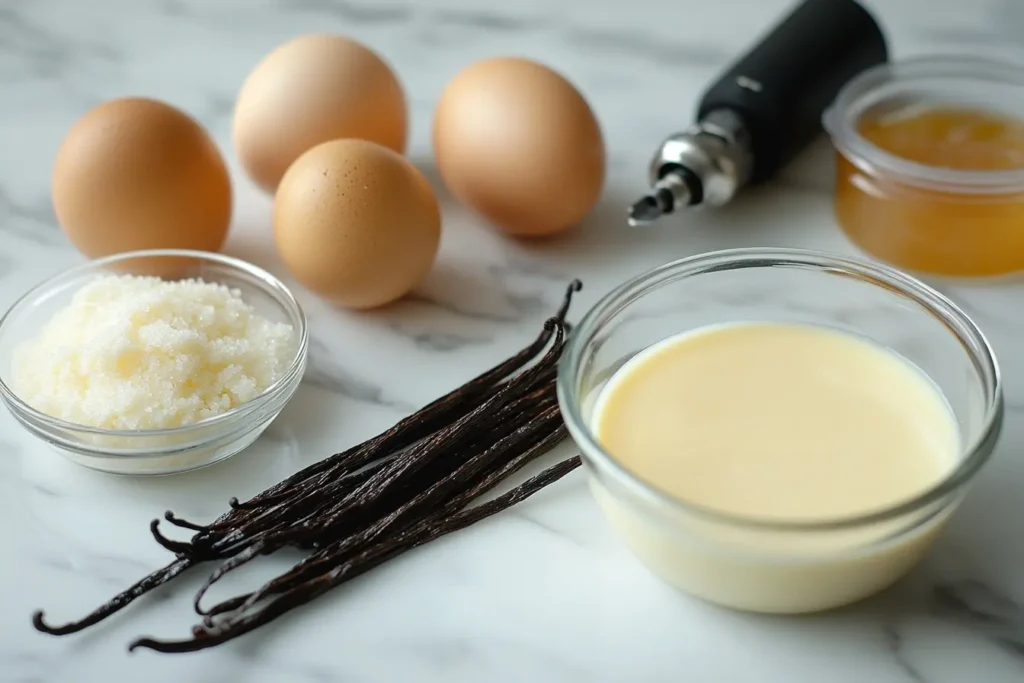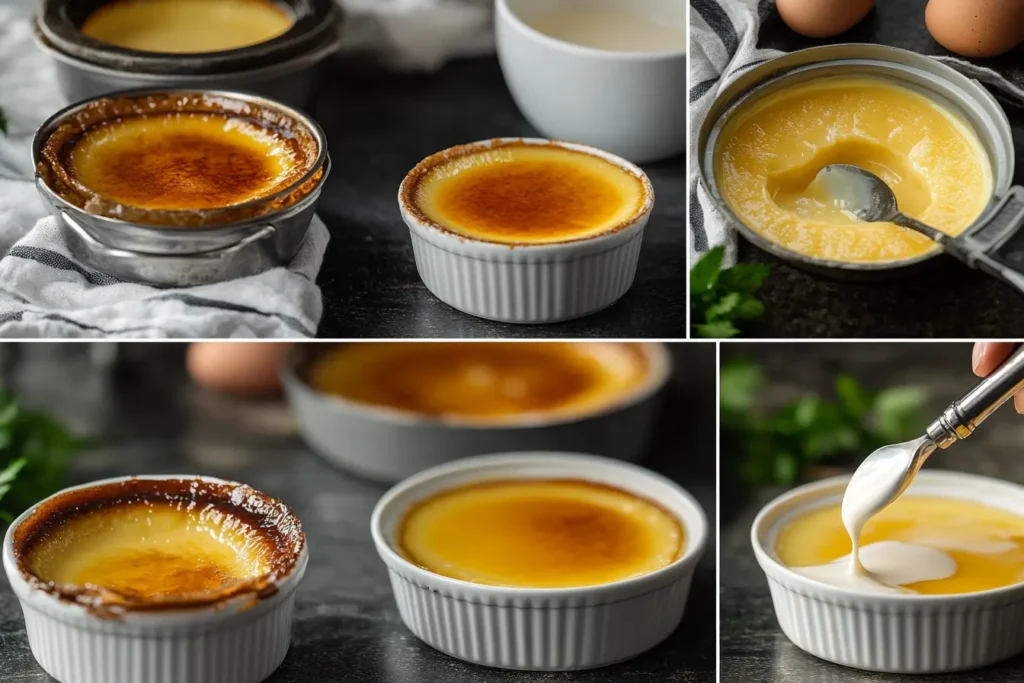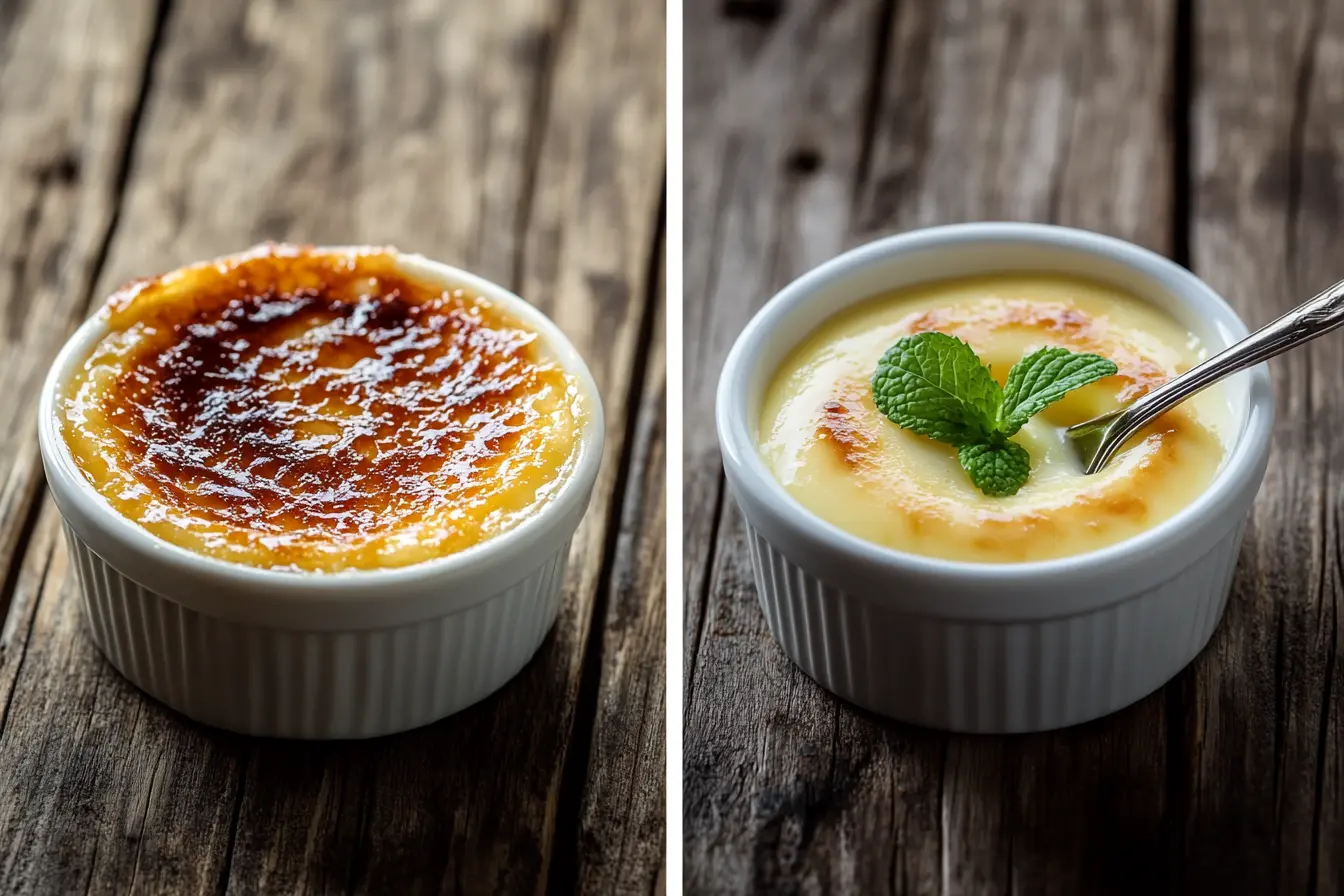What’s the difference between crème brûlée and custard? These two classic desserts may seem similar, but they have distinct differences in texture, flavor, and preparation. While both are egg-based custards, crème brûlée is known for its rich, creamy consistency and signature caramelized sugar crust, whereas custard comes in many forms, from silky-smooth puddings to firm baked varieties.
The main distinction lies in their texture, preparation, and toppings. Crème brûlée has a rich, velvety custard base topped with a crispy caramelized sugar crust, while custard is typically served without a caramelized layer, sometimes with a sauce instead.
In this article, we’ll explore:
- The fundamentals of crème brûlée and custard
- The key differences in ingredients, texture, and cooking methods
- The various types of custards and their unique traits
- FAQs to clear up any confusion
Let’s start by understanding the basics of these two classic desserts.
Understanding the Basics of Crème Brûlée and Custard
What Is Custard?
Custard is a broad category of desserts made by thickening milk or cream with eggs. It can be served in many different forms, ranging from soft and pourable to firm and sliceable.
Here’s what defines custard:
- Core Ingredients: Typically made with milk or cream, eggs, sugar, and flavorings like vanilla or nutmeg.
- Cooking Methods: Can be baked, stirred on the stovetop, or frozen.
- Texture Variations: Can be thin and pourable (like crème anglaise) or thick and sliceable (like flan or baked custard).
Common types of custard-based desserts include:
- Crème anglaise: A thin, pourable custard often served as a sauce over cakes or fruit.
- Pastry cream: A thick, custard-like filling used in pastries and desserts like éclairs.
- Flan or crème caramel: A baked custard with a caramel sauce that forms at the bottom of the dish.
What Is Crème Brûlée?
Crème brûlée, or “burnt cream“, is a specific type of baked custard topped with a thin layer of caramelized sugar. This French dessert is known for its rich, velvety texture and signature crunchy topping.
Key characteristics of crème brûlée:
- Rich Ingredients: Made with heavy cream, egg yolks, sugar, and vanilla.
- Signature Caramelized Sugar Top: Unlike regular custards, crème brûlée has a torched or broiled sugar crust that creates a satisfying crunch.
- Baking Method: Always baked in a water bath to ensure a creamy, smooth consistency.
Essentially, crème brûlée is a custard, but not all custards are crème brûlée. Its defining feature is the torched sugar topping, which gives it a crispy contrast to the creamy custard below.
Key Differences Between Crème Brûlée and Custard
Many people wonder, what’s the difference between crème brûlée and custard? While both share a smooth, creamy texture, they have distinct differences in ingredients, preparation, and serving style. Let’s break it down.
Ingredients and Texture Differences
The main distinction between these two desserts lies in their ingredients and texture:
- Crème Brûlée:
- Made with heavy cream, egg yolks, sugar, and vanilla.
- Richer and silkier due to the high cream-to-egg ratio.
- Topped with caramelized sugar for a crunchy contrast.
- Custard:
- Made with milk, eggs, and sugar (sometimes cream is added).
- Texture varies depending on egg-to-liquid ratio—some are firm, others are pourable.
- Typically served plain or with sauce instead of a crunchy topping.
The fat content in crème brûlée gives it a more luxurious mouthfeel, while custard can range from light and delicate to thick and firm.
Cooking Methods: Baking vs. Direct Heat
Another key difference between crème brûlée and custard is how they are cooked:
- Crème brûlée is always baked in a water bath (bain-marie) and then chilled before caramelizing the top.
- Custard can be baked, stirred, or frozen depending on the type.
Different cooking techniques result in unique textures, making each dessert distinct in taste and experience.

Comparing Flavor and Toppings
Beyond texture and cooking methods, what’s the difference between crème brûlée and custard when it comes to flavor and presentation? Let’s compare.
Flavor Profiles: Sweetness and Richness
- Crème Brûlée:
- Tends to be richer and more indulgent due to the high cream content.
- Has a buttery, custard-like taste with a slight caramel note from the sugar topping.
- Custard:
- Can be light and mild or dense and creamy, depending on the recipe.
- Often flavored with vanilla, nutmeg, citrus zest, or chocolate.
Crème brûlée has a more concentrated richness, while custard’s flavor varies widely based on ingredients and preparation.
Toppings: Caramelized Sugar vs. Plain Surface
One of the most noticeable differences between crème brûlée and custard is how they’re finished:
- Crème brûlée is always topped with caramelized sugar, which is torched to create a crisp, glass-like layer.
- Custard is usually left plain or served with a sauce like caramel, chocolate, or fruit puree.
This caramelized sugar topping is what gives crème brûlée its signature crack when tapped with a spoon.
Different Types of Custards and Their Unique Traits
While crème brûlée is a type of baked custard, there are many other custard variations that differ in texture, preparation, and toppings. Understanding these differences helps clarify what’s the difference between crème brûlée and custard and how each dessert stands apart.
Crème Caramel vs. Crème Brûlée
Two of the most commonly confused custards are crème brûlée and crème caramel. While both are baked custards, they have distinct textures and toppings:
- Crème Brûlée
- Has a thick, creamy custard base.
- Features a crisp, torched sugar topping.
- Requires a blowtorch or broiler to caramelize the sugar.
- Crème Caramel
- Has a lighter, more delicate texture.
- Includes a layer of caramel sauce at the bottom that melts as it bakes.
- Flipped upside down before serving, allowing the liquid caramel to coat the custard.
While crème brûlée has a crunchy topping, crème caramel has a soft, silky caramel layer, making them texturally very different.
Flan, Pudding, and Other Variations
Beyond crème brûlée and crème caramel, custard appears in many other forms:
- Flan: Similar to crème caramel, but slightly firmer and often flavored with cinnamon or citrus.
- Pastry Cream: A thicker, stirred custard used in eclairs, tarts, and pastries.
- Pudding: While similar to custard, pudding is thickened with cornstarch or gelatin rather than eggs.
- Frozen Custard: A rich, dense ice cream-like dessert made with egg yolks for extra creaminess.
Each variation showcases how versatile custard can be, whether baked, stirred, or frozen.
Making the Perfect Crème Brûlée vs. Custard at Home
If you’re inspired to make these creamy, indulgent desserts at home, here are key tips to achieve the best results for both crème brûlée and custard.
Tips for Perfecting Crème Brûlée
A perfect crème brûlée should have a smooth, velvety custard base and a crisp, caramelized top. Here’s how to get it right:
- Use a Water Bath: Baking in a bain-marie (hot water bath) ensures even cooking and prevents curdling.
- Strain the Custard: After mixing the cream, eggs, and sugar, strain the mixture to remove any lumps.
- Chill Before Caramelizing: Let the custard set in the fridge for at least 4 hours before adding the sugar topping.
- Torch for the Perfect Crust: Use a kitchen torch to evenly caramelize the sugar without overheating the custard.
Tips for Making Smooth, Creamy Custard
Whether you’re making crème caramel, flan, or vanilla custard, these tips will help you achieve the perfect consistency:
- Whisk Gently: Over-whisking can create too many air bubbles, leading to a grainy texture.
- Cook at Low Heat: If making a stirred custard, cook slowly over low heat to avoid scrambling the eggs.
- Chill for Best Flavor: Many custards develop deeper flavors after a few hours in the fridge.
By mastering these techniques, you’ll be able to distinguish and perfect both crème brûlée and classic custards at home.

FAQs – What People Also Ask
Many people wonder, what’s the difference between crème brûlée and custard? While both share a creamy texture and egg-based structure, they have distinct characteristics that set them apart. Let’s answer some of the most frequently asked questions about these beloved desserts.
Is Crème Brûlée Just Custard with Sugar on Top?
Yes and no. Crème brûlée is a type of baked custard, but what makes it unique is its caramelized sugar topping. Unlike traditional custards, crème brûlée has:
- A rich, heavy cream-based custard that’s silkier than most other custards.
- A torched or broiled sugar crust that provides a satisfying crunch.
While all crème brûlées are custards, not all custards are crème brûlées.
Can You Turn Custard into Crème Brûlée?
Technically, yes! If your custard has a firm consistency (like a baked custard), you can sprinkle sugar on top and torch it to create a brûlée-style crust. However, if your custard is too soft or runny, the sugar won’t caramelize properly.
Which Is Easier to Make: Custard or Crème Brûlée?
Custard is generally easier to make because it requires fewer steps. Crème brûlée needs:
- A water bath for even baking.
- Chilling time to set the custard.
- Caramelization with a torch or broiler.
If you want a simple, no-fuss dessert, classic custard is the better choice. However, if you’re looking for a restaurant-style treat, crème brûlée is worth the extra effort!
Can You Use Store-Bought Custard for Crème Brûlée?
You can, but it won’t have the same rich texture and depth of flavor as homemade crème brûlée. Store-bought custard often has thickeners like cornstarch, which affect its consistency. If you do use pre-made custard, ensure it’s firm enough to support the caramelized sugar layer.
Final Thoughts – A Delicious Debate
After exploring what’s the difference between crème brûlée and custard, it’s clear that these two desserts share similarities but have distinct differences.
Why Both Desserts Are Worth Trying
- Custard is versatile and easy to make, perfect for a quick and creamy dessert.
- Crème brûlée is rich, elegant, and visually stunning, ideal for special occasions.
- Each dessert has unique textures and flavors, making them stand out in their own way.
Which One Should You Make?
If you prefer simple, classic flavors, go for custard. But if you’re feeling fancy and want that satisfying caramelized crunch, crème brûlée is the way to go! Either way, both desserts offer a luxurious, creamy experience that dessert lovers can’t resist.
💡 Want to try making these desserts at home? Check out our custard and crème brûlée recipes for step-by-step guides! 🍮🔥

